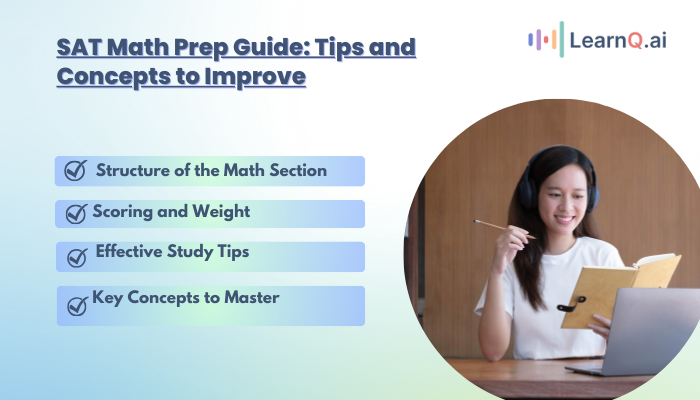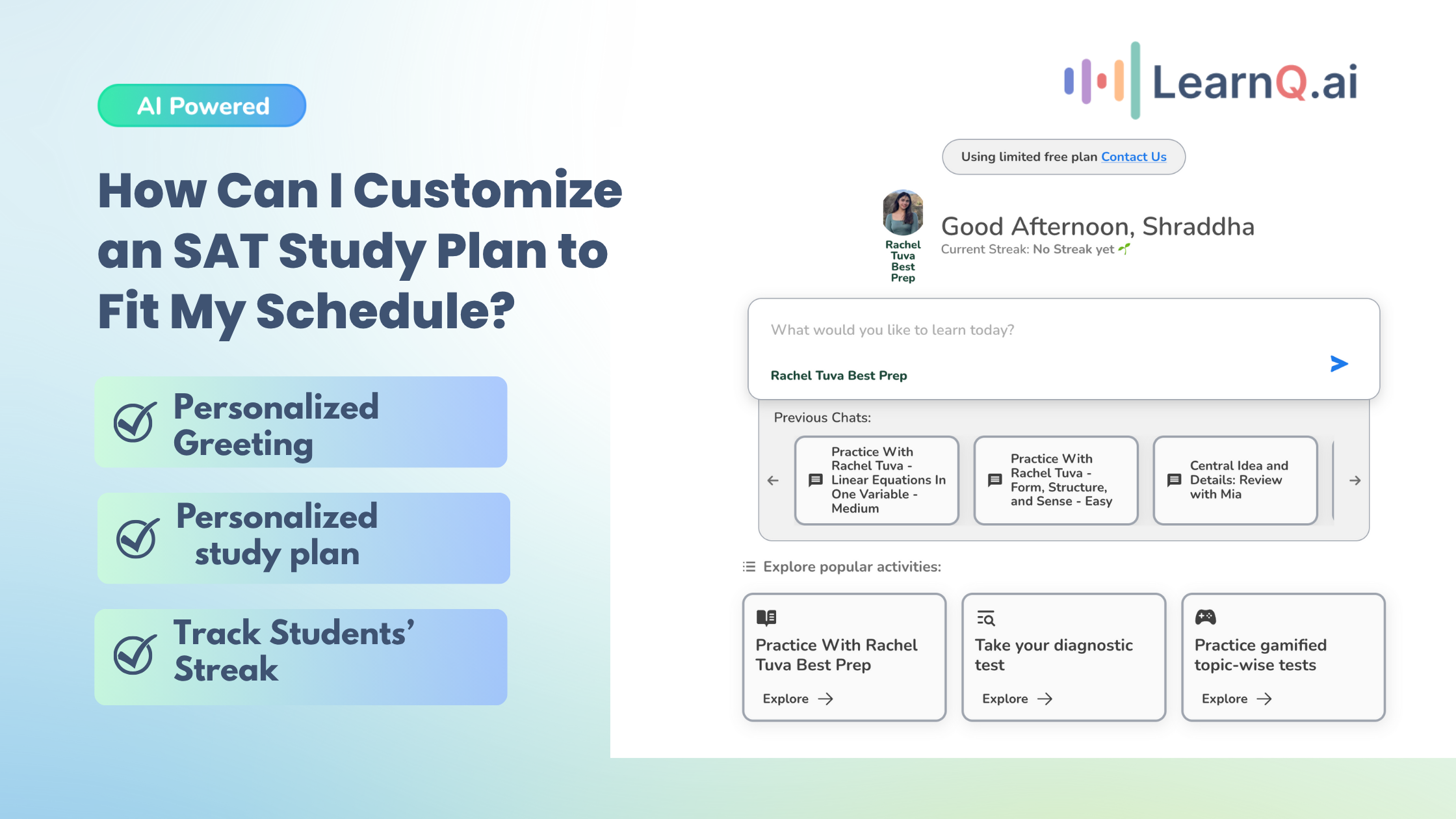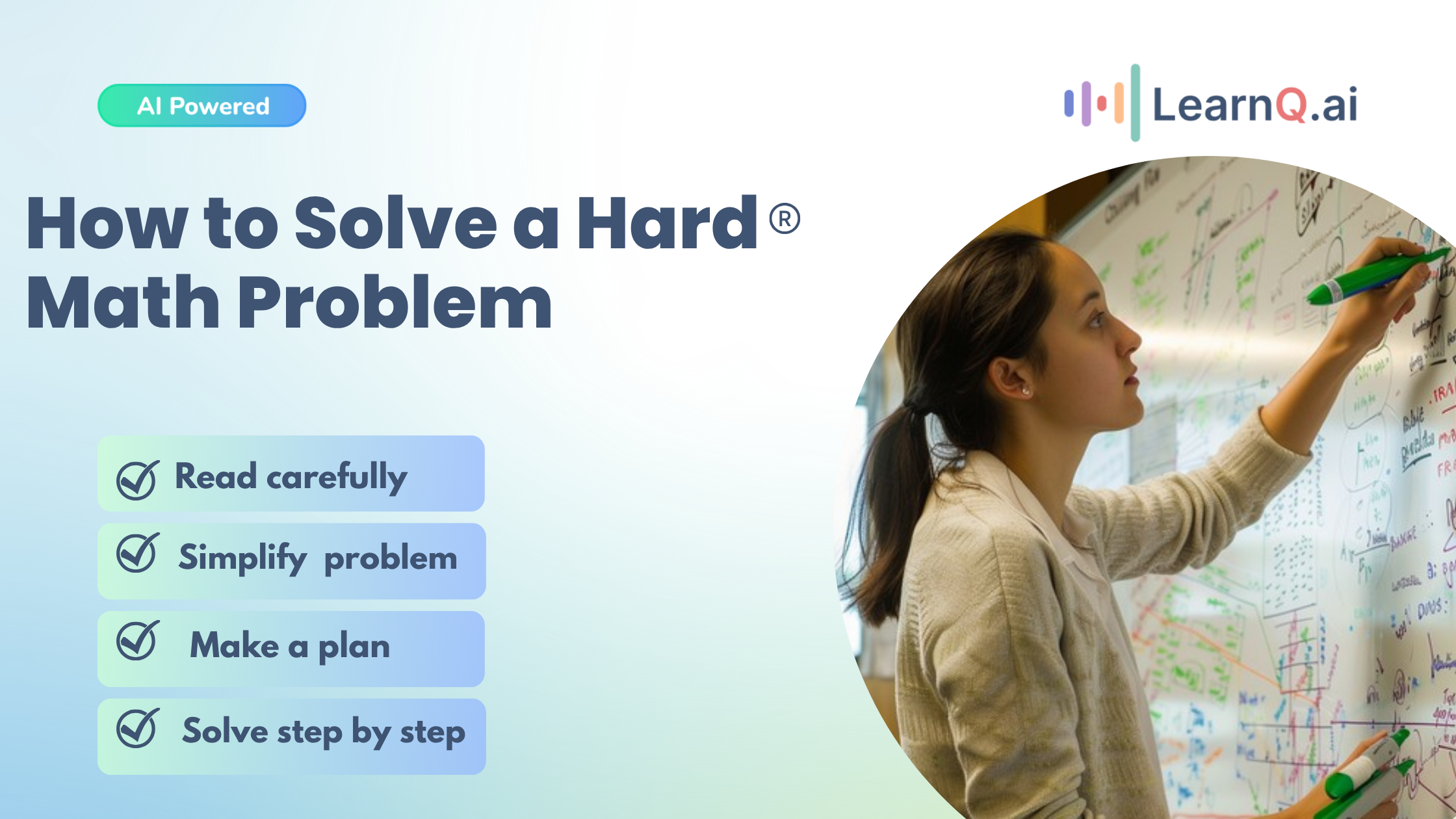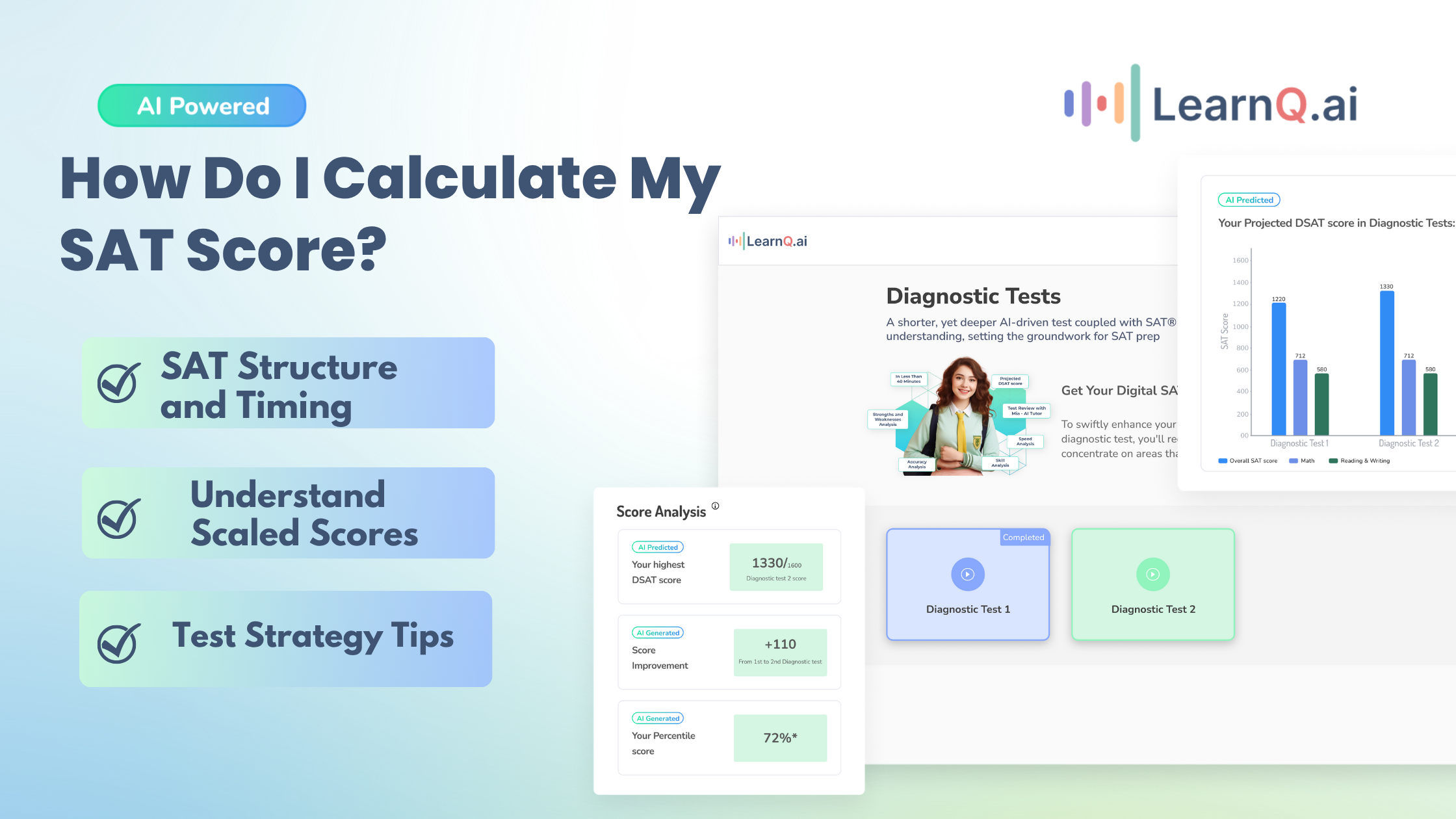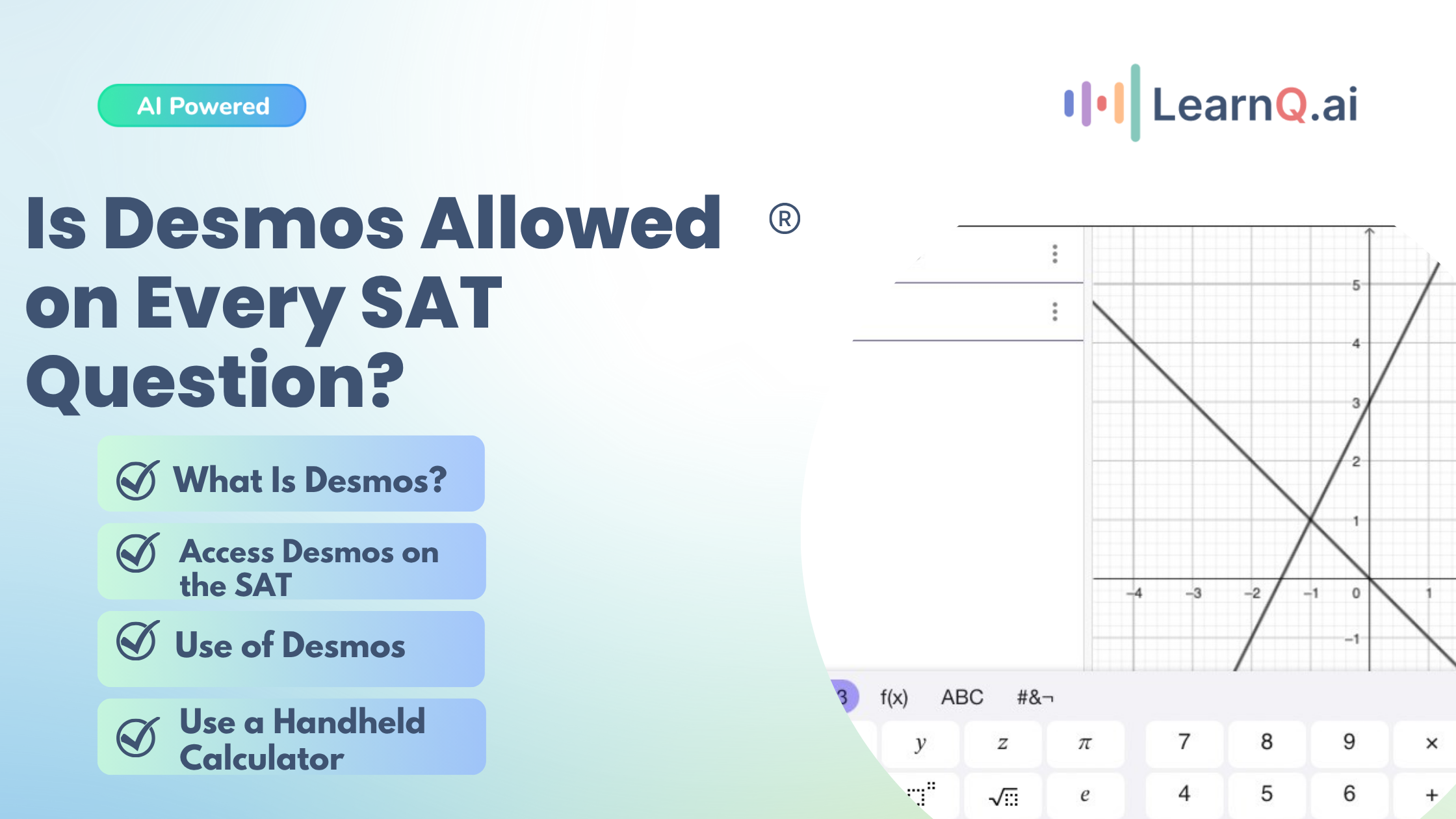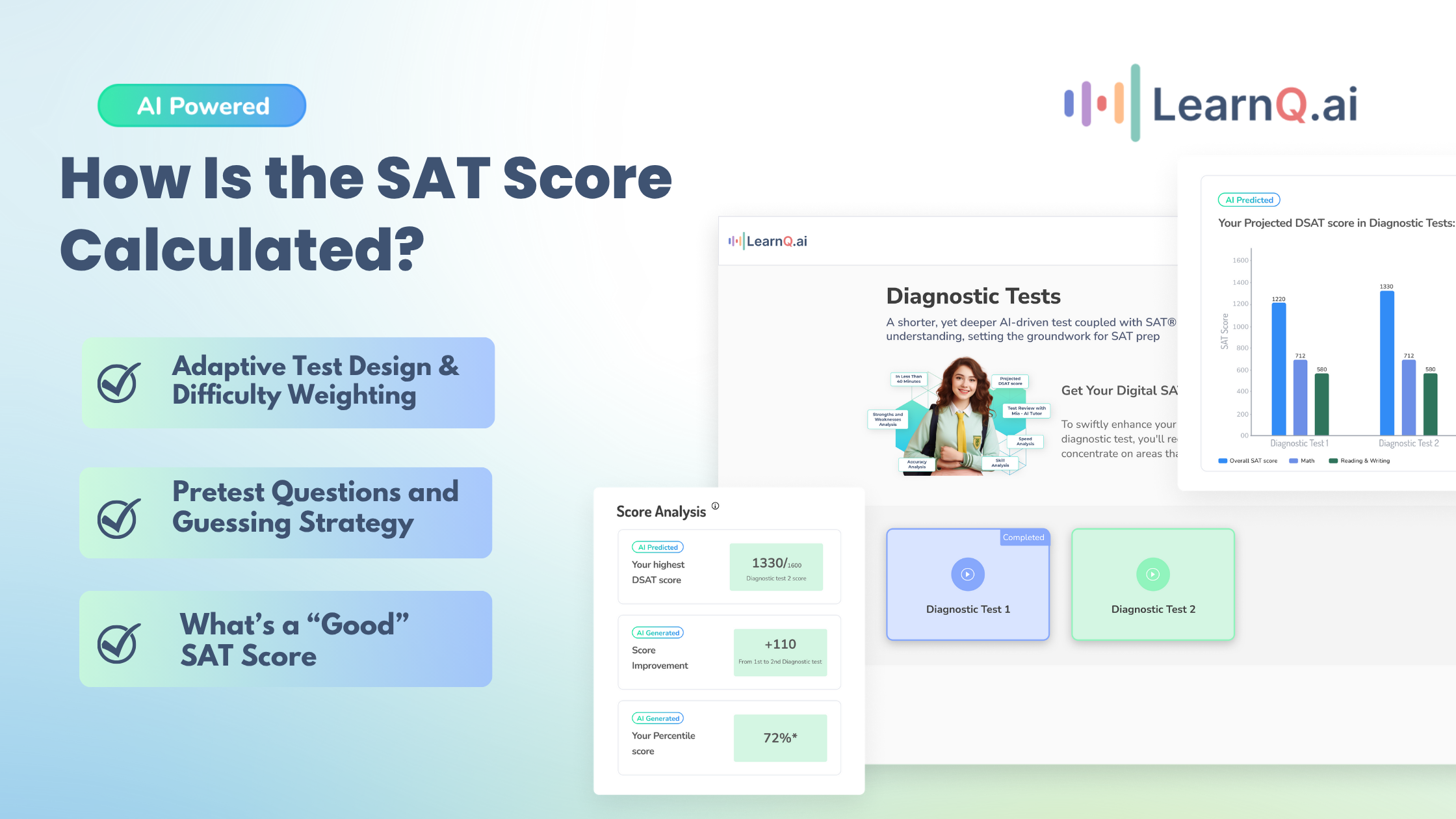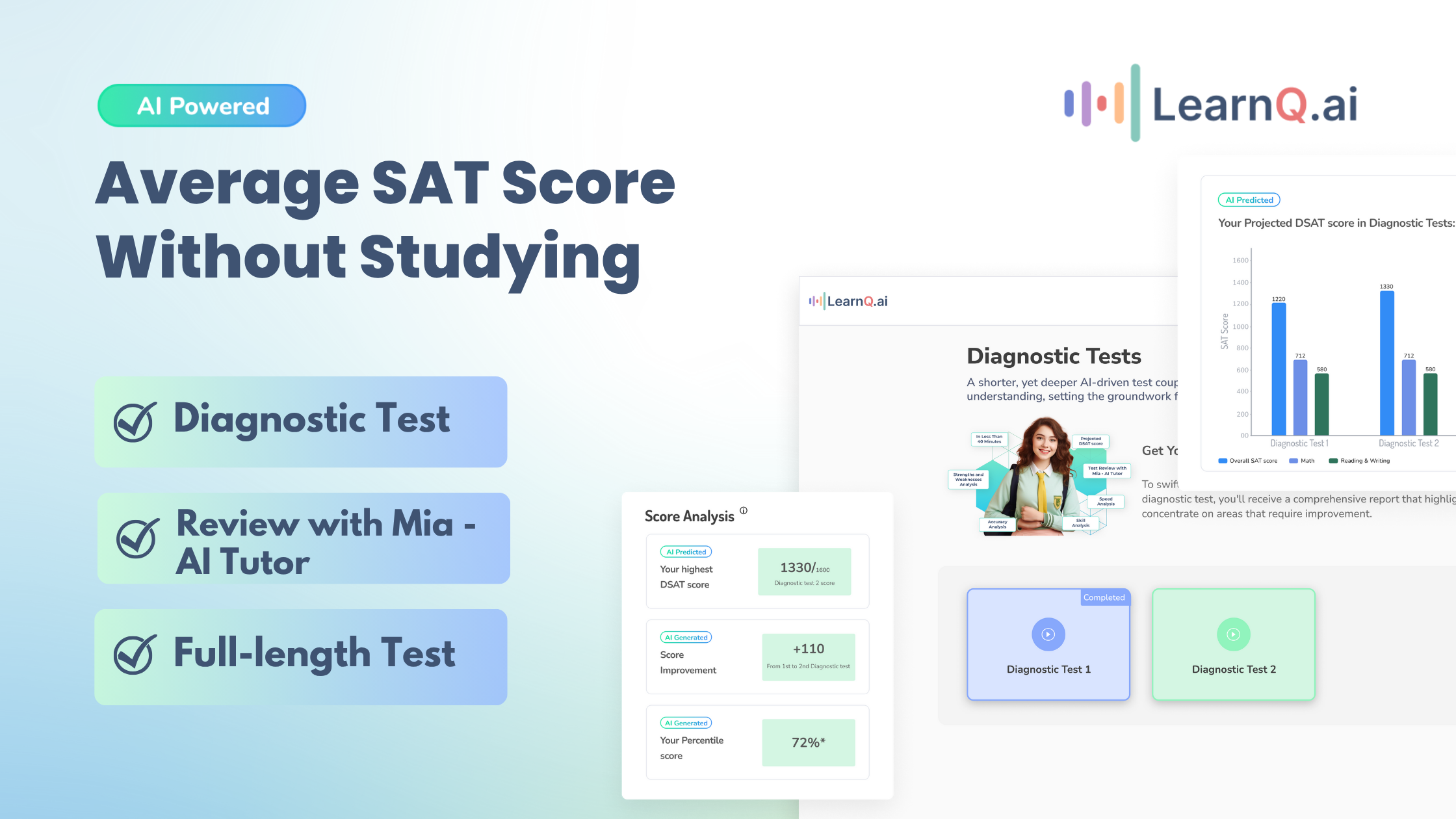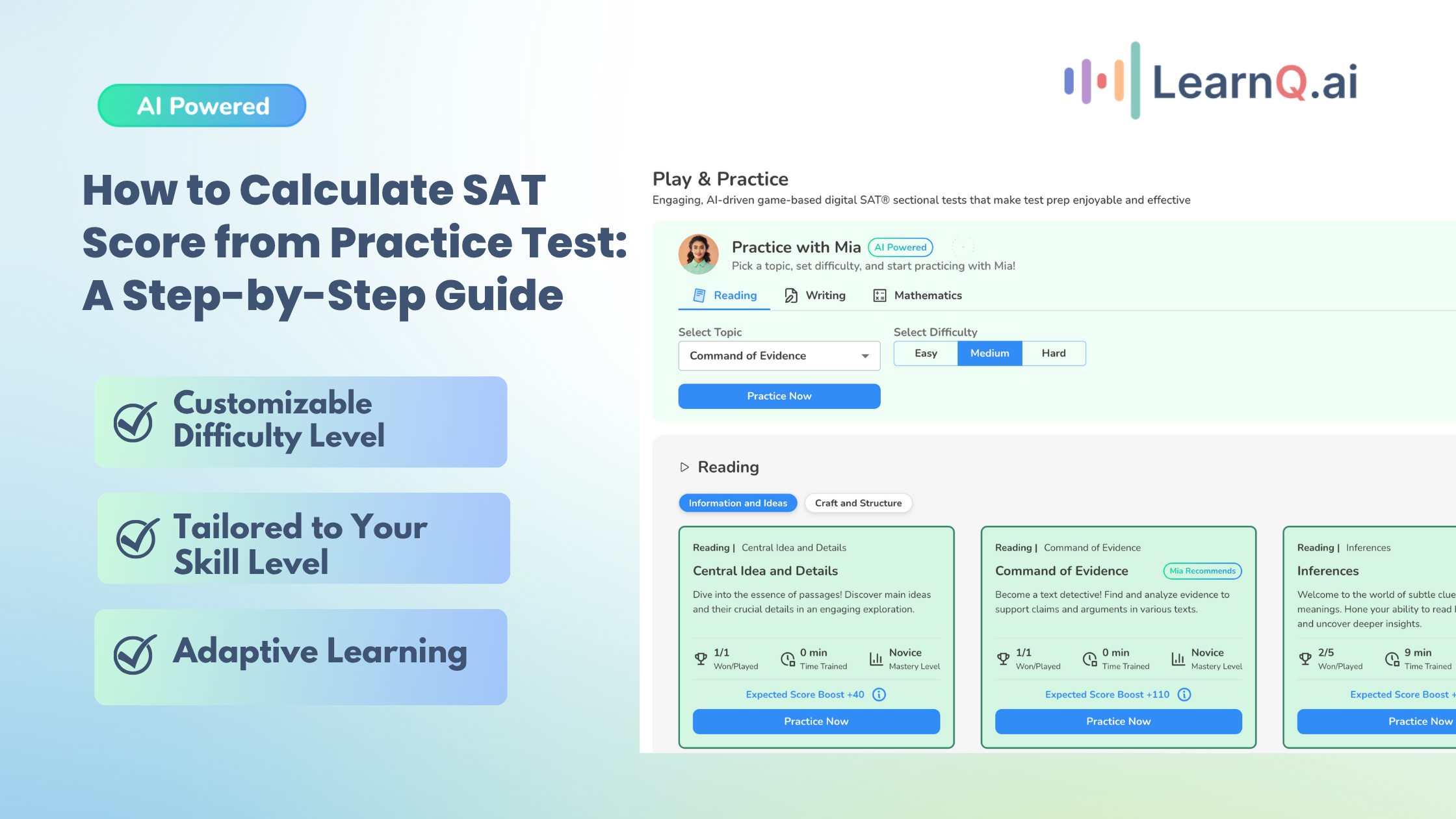Getting ready for the SAT Math section and feeling the pressure? Don’t worry, you’re not alone. You can boost your score significantly with the right strategies and a solid understanding of key concepts. Whether you’re a student aiming high, a teacher guiding your class, or a parent supporting your child, this guide will help you make a difference.
The first SAT in 1926 was a whirlwind 97-minute test with 315 questions over nine different sub-tests, including analogies and artificial language!
LearnQ.ai is Powered by VEGA AI—Is your Institute Next?
Give students a Duolingo-style test-prep platform with Shopify-level customization for tutors and institutes.
One classic math problem asked: “A man spent one-eighth of his spare change for a package of cigarettes, three times as much for a meal, and then had eighty cents left. How much money did he have at first?”
While the test has changed a lot, the need for strong problem-solving skills hasn’t. Here’s your SAT math help guide, full of practical tips and concepts to confidently tackle the test. Dive in!
Understanding the SAT Math Section
The SAT Math section is designed to test the most critical math concepts needed for future success in college and careers. It covers four main areas, as given below.
| Math Area | Focus |
| Algebra | Solving equations and understanding expressions |
| Advanced Math | Mastering complex equations and functions |
| Problem-solving and Data Analysis | Interpreting and analyzing real-world data |
| Geometry and Trigonometry | Applying properties of shapes and trigonometric relationships |
Divided into two modules, this section includes both multiple-choice and student-produced response questions. About 30% of the questions are real-world “in-context” problems that challenge you to apply math skills to scenarios from science, social studies, or everyday life.
Now that you have a grasp of what the SAT Math section covers, let’s get into how it’s structured and what types of questions you can expect.
Structure of the Math Section
The SAT Math section is split into two parts: the No Calculator and Calculator sections. Together, they evaluate your problem-solving skills and understanding of fundamental and advanced math concepts.
- No Calculator Section: In this portion, you’ll be required to solve problems without a calculator. It emphasizes your ability to think critically and perform calculations accurately, focusing on algebra and arithmetic skills.
- Calculator Section: Here, you can use a calculator, which is beneficial for solving complex equations and interpreting data. However, knowing when a calculator is necessary versus when it might slow you down is essential.
Types of Questions
The SAT Math section includes two types of questions:
- Multiple-Choice Questions: These present four answer choices, and you select the correct one.
- Grid-In Questions (Student-Produced Responses): You must solve the problem and enter your answer in the provided grid. These questions don’t offer answer choices, so they test your precision and problem-solving skills.
Enhance your Digital SAT study routine with AI-driven insights and personalized practice tests.
Overview of Content Categories
The math content is divided into four major categories:
- Heart of Algebra: Focuses on linear equations, systems of equations, and functions. These questions test your ability to analyze, solve, and create equations and inequalities.
- Problem-Solving and Data Analysis: Involves ratios, percentages, and data interpretation. You’ll encounter problems that require analyzing data sets, understanding trends, and using proportional reasoning to solve real-world challenges.
- Passport to Advanced Math: Deals with complex equations and functions, including quadratic and exponential expressions. These questions require a deep understanding of how various mathematical expressions can be manipulated.
- Additional Topics in Math: Covers geometry, trigonometry, and the basics of complex numbers. You’ll apply geometric concepts, understand the properties of shapes, and use trigonometric relationships to solve problems.
Types of Math Tested
The math questions are organized into four categories, appearing in both the No Calculator and Calculator modules. Each module arranges the questions from easiest to hardest, allowing you to build confidence and showcase your abilities as you progress.
| Type of Math | Number of Questions |
| Algebra | 13–15 |
| Advanced Math | 13–15 |
| Problem-solving and Data Analysis | 5–7 |
| Geometry and Trigonometry | 5–7 |
Scoring and Weight
The SAT Math section significantly shapes your overall SAT score and is a key factor in college admissions, especially for students pursuing STEM fields. Here’s a breakdown of how the Math section is scored and why it matters.
How the Math Section Is Scored?
Understanding the scoring system can help you better approach your test strategy. Here’s how it works:
- Score Range: The Math section scores 200 to 800, contributing half of your Total SAT Score (400 to 1600).
- Raw Score Calculation: Your raw score is the total number of questions answered correctly. The SAT does not penalize you for wrong answers, so it’s in your best interest to make an educated guess rather than leave a question blank.
- Score Conversion: Raw scores are then converted into a scaled score. This conversion accounts for slight differences in test difficulty, ensuring fairness across different test dates and versions.
Additional Scoring Details
- Test Score Range: The Math section is also broken down into a test score ranging from 10 to 40, which reflects your performance more specifically.
- Percentiles: Your Math percentile gives you context on your performance compared to other students. For instance, if your Math percentile is 57, you’ve scored equal to or better than 57% of test takers.
- Benchmarks: The college readiness benchmark for Math is 530. Scoring at or above this benchmark indicates you are on track for college-level math courses. Falling below it suggests areas for improvement, and resources like Skills Insight™ can help you focus on these.
Importance of the Math Score in College Admissions
- Significance for STEM Majors: Your Math score carries significant weight if you’re aiming for a STEM program. Colleges look at it closely to evaluate your preparedness for math and science-related coursework.
- Competitive Edge: A strong Math score can enhance your college application, especially for selective universities. Even for non-STEM fields, a solid performance in Math can positively influence admissions decisions.
Key Concepts to Master
While on your hunt for SAT math help, remember you don’t need to be a math whiz or know every complex formula out there. In fact, one common misconception is that the SATs advanced math concepts like calculus or matrices.
The truth? The test focuses heavily on practical skills: lots of algebra, some arithmetic, basic statistics, and a small amount of geometry.
Mastering the SAT Math section involves understanding key concepts and applying smart strategies. With the right SAT math strategies, you can approach each question confidently, knowing exactly where to focus your efforts.
Check out the essential concepts you need to master for success.
1. Heart of Algebra
Algebra forms the backbone of the SAT Math section, emphasizing your ability to solve equations, work with inequalities, and interpret linear functions. This category tests your ability to understand and manipulate algebraic expressions in real-world contexts, a crucial skill for college and beyond.
Here are some of the key skills to focus on:
- Solving Equations and Inequalities: Be prepared to solve linear equations and inequalities, including those with variables on both sides. Practice rearranging formulas to isolate a variable and apply these skills to word problems.
- Interpreting Linear Functions: Understand how to read and analyze linear graphs. You should be able to interpret the slope and y-intercept, as well as apply this understanding to scenarios presented in the questions.
Tips for Mastering Algebraic Concepts:
- Practice Simplifying: Work on simplifying expressions and understanding how different algebraic terms interact. The more efficient you become at recognizing patterns, the quicker you’ll solve problems on test day.
- Break Down Word Problems: When faced with a word problem, translate the words into equations step-by-step. Identify key information and variables, and remember to check your work.
- Use Graphs to Your Advantage: Visual representations can make complex problems clearer. Practice plotting equations and understanding how changes in variables affect the graph.
Master the Heart of Algebra and boost your SAT Math score with precision. Get your free personalized SAT study plan from LearnQ.ai. Our AI technology will help target your strengths and weaknesses and guide you toward your 1500+ dream score.
2. Problem Solving and Data Analysis
This section of the SAT Math test measures your ability to interpret and analyze data—an essential skill for college courses and real-world situations. From understanding graphs and tables to calculating percentages, these questions require a blend of critical thinking and practical math skills.
Importance of Interpreting and Analyzing Data
Problem-solving and Data Analysis questions assess your ability to work with data presented in various formats. Whether you understand trends from a line graph or calculate percentage changes, your proficiency here can reflect your readiness for college-level work.
Drawing accurate conclusions from data is a skill that is highly valued in academics and many professional fields.
Common Types of Questions:
- Graphs and Tables: You’ll often encounter questions that require reading and interpreting information from charts, bar graphs, scatterplots, and tables. Be prepared to analyze trends and compare data points effectively.
- Percentages and Ratios: Expect problems involving percentage increase or decrease, ratios, and proportional relationships. These questions may relate to everyday scenarios, like calculating discounts or analyzing survey results.
- Statistical Analysis: Some questions will test your understanding of mean, median, and mode or require you to interpret standard deviation and data distribution.
LearnQ.ai offers interactive exercises to sharpen your data interpretation skills with real-world data sets and graph-based problems. The platform provides instant feedback and adaptive learning paths, ensuring you efficiently strengthen your problem-solving abilities.
3. Passport to Advanced Math
The Passport to Advanced Math section focuses on more complex math concepts like functions and polynomial expressions. These questions require a deeper understanding of how to manipulate and interpret equations, making it essential to master advanced algebraic skills.
Strategies for Tackling Complex Problems:
- Understand Function Behavior: Familiarize yourself with different functions and their properties, like linear, quadratic, and exponential functions. Be ready to analyze and solve equations involving these functions.
- Break Down Polynomial Expressions: Practice simplifying and factoring polynomials and understand how to use these skills to solve equations efficiently.
- Stay Methodical: For complex problems, take a step-by-step approach to avoid simple errors and ensure accuracy.
LearnQ.ai offers full-length practice tests that mirror the College Board’s format, helping you build confidence and be exam-ready. With targeted practice and in-depth feedback, you’ll develop the skills needed to tackle even the toughest math problems.
4. Additional Topics in Math
This section covers geometry, trigonometry, and the basics of complex numbers, making up a smaller but significant portion of the SAT Math test. You’ll need to know concepts like the properties of shapes, right triangle trigonometry, and how to work with complex numbers.
Importance of These Topics
Though fewer in number, these questions can be the deciding factor in achieving a high score. Mastering these concepts ensures you’re well-rounded in your math skills and ready to tackle any challenge the SAT throws your way.
LearnQ.ai features Mia, your AI tutor for the Digital SAT, harnessing the power of Gen AI to offer personalized guidance. Mia tailors your prep journey to your specific strengths and weaknesses. These provide targeted support and customized practice to help you master every SAT Math concept efficiently.
Also Read: The Benefits of Taking a Full-Length Digital SAT Mock Test
Effective Study Tips
When it comes to preparing for the SAT Math section, consistent practice is key to improving your skills and boosting your confidence. Working through various SAT math practice problems can help you identify your strengths and areas for improvement, ensuring you’re well-prepared for test day.
Here are some effective study tips to maximize your practice and get your desired results.
1. Creating a Study Schedule
Consistent practice is essential as you prepare for the SAT, especially for the Math section. Developing a well-structured study schedule helps ensure you cover all the necessary content without feeling overwhelmed. Here’s how to do it effectively:
- Consistent Practice: Spreading your study sessions over weeks or months is more effective than cramming. Consistent practice allows you to retain concepts better and stay on top of your game as test day approaches.
- Balancing Study Time: Allocate time for all SAT sections, not just Math. A balanced approach helps you stay confident throughout the exam and avoids neglecting areas that need attention.
- Using LearnQ.ai for a Personalized Plan: LearnQ.ai can create a study plan tailored to your unique needs, focusing on your strengths and weaknesses. This personalized approach ensures efficient use of your study time.
2. Practicing with Real SAT Questions
Familiarity with actual SAT question types is crucial for success. The more comfortable you are with the format and style of questions, the less stressed you’ll feel on test day, and the quicker you’ll be able to tackle each problem.
Strategies for Effective Practice:
- Timed Drills: Simulating the test environment with timed practice sessions helps you manage your pace and improve your time management. Practice completing questions within specific time limits to build speed and accuracy.
- Review Sessions: After each practice session, review your answers thoroughly. Understanding and learning from your mistakes is as important as getting questions right.
- Accessing LearnQ.ai’s Resources: LearnQ.ai offers a comprehensive database of past SAT questions, providing you with realistic practice opportunities. Working through these questions helps you understand the test structure and develop effective strategies for each question type.
Also Read: Digital SAT Practice Questions & Resources
3. Reviewing Mistakes
Analyzing your mistakes is a vital part of improving your SAT Math performance. Understanding where you went wrong helps pinpoint your weaknesses and ensures you don’t repeat the same errors.
Techniques for Analyzing Errors:
- Error Analysis: Go beyond just noting which questions you missed—understand why you got them wrong. Was it a calculation mistake, a misunderstanding of the question, or a knowledge gap?
- Revisit Challenging Concepts: Focus on reviewing and practicing the concepts that consistently give you trouble. Mastery comes from revisiting and reinforcing these areas until they become second nature.
- Using LearnQ.ai for Improvement: LearnQ.ai’s feedback and progress tracking features provide insights into your performance, highlighting patterns in your mistakes and suggesting targeted practice. This data-driven approach ensures efficient study and continuous improvement.
Test-Taking Strategies
When it comes to acing the SAT Math section, knowing your stuff is half the battle; the other half is playing it smart. Think of test-taking strategies as your secret weapon, like having a GPS when everyone else is using a paper map.
With the right SAT math tips and tricks, you’ll easily and confidently get through even the trickiest questions. Here’s a breakdown of these strategies to help you work faster, stay calm, and maximize your score.
Enhance your Digital SAT study routine with AI-driven insights and personalized practice tests.
1. Time Management
Managing your time effectively in the SAT Math section is like playing a game of chess: every second counts, and strategy is key. You want to move through questions confidently but not so fast that you make careless mistakes.
Here are some practical tips to stay on track.
- Pace Yourself: Start with the easier questions to build momentum, then circle back to tackle the tougher ones. Remember, every question is worth the same amount, so don’t waste too much time on one problem.
- Use Time Wisely: If you’re stuck, take an educated guess and move on. If you have extra time, flag challenging questions to revisit.
Common Time Management Mistakes to Avoid
Here are some frequent time management mistakes and strategies to help you avoid them during the SAT Math section.
| Mistake | How to Avoid? |
| Spending too much time on one question | Set a time limit per question and move on if you’re stuck. |
| Rushing through easy questions | Take a moment to double-check the answers you know are simple. |
| Not budgeting time for review | Save 5-10 minutes at the end to review flagged questions. |
How LearnQ.ai Can Help?
LearnQ.ai’s simulated practice tests mimic the SAT’s time constraints, helping you practice pacing and refine your time management skills under real test conditions.
2. Guessing and Elimination
Sometimes, it’s better to make a smart guess than to leave a question blank on the SAT Math section. The key is knowing when to guess and improving your odds with strategic elimination.
Here’s when to guess and how to eliminate:
- Use the Process of Elimination: Cross out any obviously wrong answers. The fewer choices left, the higher your chances of guessing correctly.
- Look for Patterns: SAT questions often have clues. For example, rule out odd-numbered options if a question deals with even numbers.
- Avoid Overthinking: If you’re down to two choices and still unsure, trust your instincts and pick one. Don’t spend precious time second-guessing.
- Estimate First: If possible, estimate the answer before considering the options. This will eliminate far-off choices.
- Work Backwards: Plug in answer choices to see which one fits the problem, especially for equations and inequalities.
Practice with LearnQ.ai
LearnQ.ai offers scenarios specifically designed to practice and refine your guessing strategies. These exercises help you get comfortable making educated guesses and using elimination tactics, boosting your confidence for test day.
3. Calculator Use
Your calculator can be a powerful ally in the SAT Math section—but only if you use it wisely. Think of it as a trusty sidekick, not a crutch. Knowing when and how to use it can save time, but over-relying on it can slow you down or lead to mistakes.
Here are some guidelines for effective calculator use:
- Know What It’s Good For: Use your calculator for complex calculations, like working with decimals or solving systems of equations, but don’t waste time inputting simple arithmetic.
- Double-Check Entries: Always review what you’ve typed in. A single wrong keystroke can lead to an incorrect answer, so be cautious.
Common Pitfalls to Avoid
Below are some common calculator pitfalls to watch out for so you can avoid unnecessary mistakes on test day.
| Pitfall | Explanation |
| Overusing the Calculator | Doing every calculation on your calculator can slow you down. Sometimes, mental math or estimation is faster and more efficient. |
| Relying on Memory Functions | Be cautious with memory features. Clearing memory or forgetting values can lead to confusion and mistakes. |
| Ignoring Calculator Settings | Ensure your calculator is in the correct mode (e.g., degrees vs. radians) for trigonometry questions, as the wrong setting can lead to incorrect answers. |
Practice with LearnQ.ai
LearnQ.ai offers tailored exercises that simulate real SAT problems, teaching you when to use your calculator and when to rely on other strategies. With tips and practical examples, you’ll learn to use your calculator efficiently and avoid common errors.
Also Read: Tips for Solving Problems on SAT Practice Test With Study Plan
Utilizing LearnQ.ai for Comprehensive Prep
To get the most out of your SAT Math prep, having the right resources can make all the difference. Personalized and strategic practice is key, and that’s where LearnQ.ai comes in, offering the SAT math help you need to boost your score.
With tools designed to adapt to your strengths and address your weaknesses, LearnQ.ai provides a comprehensive and customized approach to your SAT Math preparation.
Here are some of our features to help you prep well.
- Free Diagnostic Test: Assess your current skills and create a customized study plan. LearnQ’s diagnostic tests predict your SAT score and guide you in developing an effective study strategy.
- Practice and Play: Engage with LearnQ’s SAT Practice Tests and DSAT Practice Tests for 2024. Experience a gamified, adaptive learning environment with over 10,000 new Digital SAT questions based on the College Board’s latest pattern.
- Full-Length Tests: Challenge yourself with Full-length DSAT Practise Tests. LearnQ provides digital SAT questions and resources, including access to Bluebook DSAT Test 2024, for a realistic testing experience.
- AI Tutor: LearnQ’s AI Tutor, Mia, offers personalized learning support. Whether you need help with Math or prefer tailored guidance, Mia adapts to your learning pace and style to ensure a focused study approach.
How Does LearnQ.ai Align with Individual Study Needs and Goals?
LearnQ.ai provides a tailored SAT prep experience, adapting to your unique strengths and areas for improvement. Here’s how it supports your study journey:
- AI-Driven Assessments: Identify your strengths and highlight areas needing more focus.
- Customized Study Plans: Adjust your practice schedule based on your progress and goals.
- Targeted Practice: Offers focused exercises on specific concepts, like algebra or data analysis, where you need extra SAT math help.
- Adaptive Learning: Modifies your learning path as you improve, ensuring continuous and efficient progress.
Testimonials and Success Stories
Our users’ experiences spotlight LearnQ.ai’s impact on SAT preparation for students, educators, and businesses alike. Here’s what some of them have to say about LearnQ Success Stories, showcasing their genuine progress and achievements.
- Stephen A. Johnson: “LearnQ has done all the work for me, and my students can reap the benefits right away.”
- Raghavender J., Founder, Score99Percentile: “LearnQ came as a breath of fresh air.”
- Mo Kaushal (M.Ed., J.D. – 2025), CEO, MK Elite Education LLC: “My students’ SAT scores improved significantly.”
- Dave Walker, Founder, Quiz Hacker Test Prep: “It enables me to analyze students’ performance more efficiently and address errors.”
- Laura Oliveira De Carvalho, Student: “I got into the Harvard Summer Program.”
- Garima Rai, CEO and Co-founder, onlinechalk: “One-stop solution for students, teachers, and business owners.”
- Dheeraj: “Mia helped me to review my mistakes.”
- Rinaa Puri Handa, Founder & Director, USA Testmasters: “My revenue grew by 3x.”
- Punit Ahuja, Founder, LessonBoard: “Mastering topics with Play & Practice is a game changer.”
- Shailendra Garg, Founder, The Smart Test Prep: “Truly love LearnQ’s round-the-clock support.”
LearnQ.ai is powered by VEGA AI—Is your institute next?
Offer students a Duolingo-style test-prep platform with Shopify-level customization for tutors and institutes.






Conclusion
As you work through the SAT Math section, maintain a consistent study schedule emphasizing algebra, data analysis, and practical test-taking tactics like time management and calculator usage. Solving real SAT math problems will improve your grasp of the material and boost your confidence.
Ready to improve your SAT Math score and meet others who are doing the same?
Get started with LearnQ.ai for customized study help and a range of resources. Additionally, join the “SAT students on Discord” community to swap tips, get advice, and tackle common hurdles together in a welcoming space. Register today to take advantage of free diagnostic tests that will identify both your strengths and areas needing work. Let’s master the SAT Math section together!

